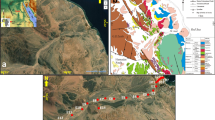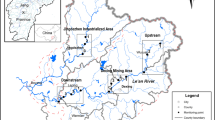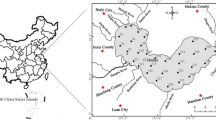Abstract
Xiamen Bay (XMB) has received substantial loadings of pollutants from industrial and municipal wastewater discharged since the 1980s. To assess ecological risks and the current spatial changes of metal contaminants in bottom surface sediments, 12 samples were collected. Samples were subjected to a total digestion technique and analyzed by ICP–OES for Cu, Pb, Zn, Cr, and Cd, and by AFS for Hg and As. Among these metals, Zn had the highest values (68–268 mg kg−1), followed by Pb (27–71 mg kg−1), and lower concentrations were found for Cd (42–1,913 μg kg−1) and Hg (0–442 μg kg−1). In comparison with the average crustal abundance values, the results indicated that nearly half of the sediment samples of XMB and its adjacent areas were contaminated by Cd, Pb, Zn, and As. Furthermore, based on the modified BCR sequential extraction procedure, the chemical speciation of heavy metals (Cd, Cr, Cu, Pb, Zn, Hg, and As) in selected sediment samples were evaluated in this study. Data from BCR sequential extractions indicated that Cd posed a medium ecological risk, whereas, Cr posed low risk since its exchangeable and carbonate fractions were below 4%, and the mobility of heavy metals in XMB decreased in the order Cd > Pb > Cu > Zn > Hg > As > Cr. By applying mean effects range median quotients (mERMQ), the results showed that Yuandang Lagoon with mERMQ value >0.5 would be expected to have the greatest potential toxic risk in amphipod within XMB and its adjacent areas.




Similar content being viewed by others

References
Arain MB, Kazi TG, Jamali MK, Jalbani N, Afridi HI, Baig JA (2008) Speciation of heavy metals in sediment by conventional, ultrasound and microwave assisted single extraction methods: a comparison with modified sequential extraction procedure. J Hazard Mater 154:998–1006
Boughriet A, Proix N, Billon G, Recourt P, Ouddane B (2007) Environmental impacts of heavy metal discharges from a smelter in Deûle-canal sediments (Northern France): concentration levels and chemical fractionation. Water Air Soil Poll 180:83–95
Caplat C, Texier H, Barillier D, Lelievre C (2005) Heavy metals mobility in harbour contaminated sediments: the case of Port-en-Bessin. Mar Pollut Bull 50:504–511
Chatterjee M, Silva Filho EV, Sarkar SK, Sella SM, Bhattachary A (2007) Distribution and possible source of trace elements in the sediment cores of a tropical macrotidal estuary and their ecotoxicological significance. Environ Int 33:346–356
Chen Z, Saito Y, Kanai Y, Wei T, Li L, Yao H, Wang Z (2004) Low concentration of heavy metals in the Yangtze estuarine sediments, China: a diluting setting. Estuar Coast Shelf Sci 60:91–100
Cobelo-García A, Prego R (2003) Heavy metal sedimentary record in a Galician Ria (NW Spain): background values and recent contamination. Mar Pollut Bull 46:1253–1262
Cuong DT, Obbard JP (2006) Metal speciation in coastal marine sediments from Singapore using a modified BCR-sequential extraction procedure. Appl Geochem 21:1335–1346
Dang TC, Jeffrey PO (2006) Metal speciation in coastal marine sediments from Singapore using a modified BCR sequential extraction procedure. Appl Geochem 21:1335–1346
Daskalakis KD, O’Connor TP (1995) Normalization and elemental sediment contamination in the Coastal United States. Environ Sci Technol 29:470–477
Demirak A, Yilmaz F, Tuna A, Ozdemir N (2006) Heavy metals in water, sediment and tissues of Leuciscus cephalus from a stream in southwestern Turkey. Chemosphere 63:1451–1458
Dickinson WW, Dunbar GB, McLeod H (1996) Heavy metal history from cores in Wellington Harbour, New Zealand. Environ Geol 27:59–69
Gasparon M, Ehrler K, Matschullat J, Melles M (2007) Temporal and spatial variability of geochemical backgrounds in the Windmill Islands, East Antarctica: implications for climatic changes and human impacts. Appl Geochem 22(5):888–905
Ghrefat H, Yusuf N (2006) Assessing Mn, Fe, Cu, Zn, and Cd pollution in bottom sediments of Wadi Al-Arab Dam, Jordan. Chemosphere 65:2114–2121
Guevara-Riba A, Sahuquillo A, Rubio R, Rauret G (2004) Assessment of metal mobility in dredged harbour sediments from Barcelona, Spain. Sci Total Environ 321:241–255
Hseu ZY (2006) Extractability and bioavailability of zinc over time in three tropical soils incubated with biosolids. Chemosphere 63:762–771
Idris AM, Eltayeb MAH, Potgieter-Vermaak SS, Grieken RV, Potgieter JH (2007) Assessment of heavy metals pollution in Sudanese harbours along the Red Sea Coast. Microchem J 87:104–112
Jain CK (2004) Metal fractionation study on bed sediments of River Yamuna. India Water Res 38:569–578
Liaghati T, Preda M, Cox M (2003) Heavy metal distribution and controlling factors within coastal plain sediments, Bells Creek catchment, southeast Queensland, Australia. Environ Int 29:935–948
Long ER, MacDonald DD, Smith S, Calder F (1995) Incidence of adverse biological effects within ranges of chemical concentrations in marine and estuarine sediments. Environ Manage 19:81–97
Long ER, Field LJ, MacDonald DD (1998) Predicting toxicity in marine sediments with numerical sediment quality guidelines. Environ Toxicol Chem 17:714–727
Long ER, MacDonald DD, Severn CG, Hong CB (2000) Classifying the probabilities of acute toxicity in marine sediments with empirically derived sediment quality guidelines. Environ Toxicol Chem 19(10):2598–2601
Long ER, Ingersoll CG, MacDonald D (2006) Calculation and uses of mean sediment quality guideline quotients: a critical review. Environ Sci Technol 40:1726–1736
MacDonald D, Carr R, Calder F, Long E, Ingersoll C (1996) Development and evaluation of sediment quality guidelines for Florida coastal waters. Ecotoxicology 5:253–278
Malferrari D, Brigatti MF, Laurora A, Pini S (2009) Heavy metals in sediments from canals for water supplying and drainage: mobilization and control strategies. J Hazard Mater 161:723–729
McCready S, Birch GF, Long ER, Spyrakis G, Greely CR (2006) Predictive abilities of numerical sediment quality guidelines in Sydney Harbour, Australia, and vicinity. Environ Int 32:638–649
Muller G (1969) Index of geoaccumulation in sediments of the Rhine River. Geol J 2:109–118
National Standard of PR China (1998) Specification for marine monitoring, part 5: sediment analysis (GB 17378.5–1998). Standards Press of China, Beijing (in Chinese)
O’Connor TP (2004) The sediment quality guideline, ERL, is not a chemical concentration at the threshold of sediment toxicity. Mar Pollut Bull 49:383–385
Pardo R, Barrado E, Perez L, Vega M (1990) Determining and association of heavy metals in sediments of the Pisucrga river. Water Res 24:373–379
Pekey H, Karak D, Ayberk S, Tolun L, Bako M (2004) Ecological risk assessment using trace elements from surface sediments of Izmit Bay (Northeastern Marmara Sea) Turkey. Mar Pollut Bull 48:946–953
Perin G, Craboledda L, Lucchese M, Cirillo R, Dotta L, Zanetta ML, Oro A (1985) Heavy metal speciation in the sediments of northern Adriatic Sea. A new approach for environmental toxicity determination. In: Lakkas TD (ed) Heavy metals in the environment, vol 2. CEP Consultants, Edinburg
Poulton DJ, Morris WA, Coakley JP (1996) Zonation of contaminated bottom sediments in Hamilton Harbour as defined by statistical classification techniques. Water Qual Res J Can 31:505–528
Rubio B, Nombela MA, Vilas F (2000) Geochemistry of major and trace elements in sediments of the Ria de Vigo (NW Spain): an assessment of metal pollution. Mar Pollut Bull 40:968–980
Tam NFY, Wong YS (2000) Spatial variation of heavy metals in surface sediments of Hong Kong mangrove swamps. Environ Pollut 110:195–205
Taylor SR (1972) Abundance of chemical elements in the continental crust; a new table. Geochimica Cosmochimica Acta 28:1273
Ure AM, Quevauviller MH, Griepink B (1993) Speciation of heavy metals in solids and harmonization of extraction techniques undertaken under the auspices of the BCR of the Commission of the European Communities. Int J Environ Anal Chem 51:135–151
Wenning RJ, Ingersoll CG (2002) Summary of the SETAC Pellston workshop on use of sediment quality guidelines and related tools for the assessment of contaminated sediments, Fairmont, Montana, USA, 17–22 August 2002. Society of Environmental Toxicology and Chemistry (SETAC), Pensacola, FL, USA
Zaharescu DG, Hooda PS, Soler PA, Fernandez J, Burghelea CI (2009) Trace metals and their source in the catchment of the high altitude Lake Respomuso, Central Pyrenees. Sci Total Environ 407:3546–3553
Zemberyová M, Bartekov J, Hagarov I (2006) The utilization of modified BCR three-step sequential extraction procedure for the fractionation of Cd, Cr, Cu, Ni, Pb and Zn in soil reference materials of different origins. Talanta 70:973–978
Acknowledgments
This work was supported by Chinese Academy of Sciences (KZCX2-YW-422-4). The authors would like to express their special thanks to Yijun Yan and Chao Cai for helping with some laboratory works. The anonymous reviewers are also appreciated for their valuable comments that have greatly improved the paper.
Author information
Authors and Affiliations
Corresponding author
Rights and permissions
About this article
Cite this article
Yan, C., Li, Q., Zhang, X. et al. Mobility and ecological risk assessment of heavy metals in surface sediments of Xiamen Bay and its adjacent areas, China. Environ Earth Sci 60, 1469–1479 (2010). https://doi.org/10.1007/s12665-009-0282-3
Received:
Accepted:
Published:
Issue Date:
DOI: https://doi.org/10.1007/s12665-009-0282-3



